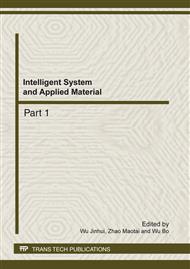[1]
D. Warnig, and G. Hallas. The chemistry and application of dyes. London: Plenum, (1990).
Google Scholar
[2]
T. Konstantinova, and P. Petrova. On the synthesis of some bifunctional reactive triazine dyes. Dyes and Pigments, 2002, 52: 115-120.
DOI: 10.1016/s0143-7208(01)00080-8
Google Scholar
[3]
P. Hoog, P. Gomez, W. Driessen, and J. Reedijk. New polydentate and polynucleating N-donor ligands from amines and 2, 4, 6-trichloro-1, 3, 5-triazine. Tetrahedron Lett, 2002, 43: 6783-6786.
DOI: 10.1016/s0040-4039(02)01498-3
Google Scholar
[4]
X. Yang, and R. Lowe. Synthesis of novel rigid triazine-based calix arenes. Tetrahedron Lett, 2003, 44: 1359-1362.
DOI: 10.1016/s0040-4039(02)02884-8
Google Scholar
[5]
L. Kyun, S. Uma, and Y. Kanga. The synthesis and properties of asymmetrically substituted 4, 4'-bis(1, 3, 5-triazin-6 -yl)diaminostilbene-2, 2'-disulfonic acid derivatives as fluorescent brighteners. Dyes and Pigments, 2005, 64: 25-30.
DOI: 10.1016/j.dyepig.2004.03.016
Google Scholar
[6]
G. Joseph. Fire retardancy of polymeric materials. New York: Marcel Dekker, Inc, (2000).
Google Scholar
[7]
S. Gaan, and S. Gang. Effect of phosphorus flame retardants on thermo-oxidative decomposition of cotton. Polymer Degradation and Stability, 2007, 92: 968-974.
DOI: 10.1016/j.polymdegradstab.2007.03.009
Google Scholar
[8]
O. Nerea, S. Norman, and M. Papanastasiou. Hydrolytic stability and hydrolysis reaction mechanism of bis (2, 4- ditertbutyl) pentaerythritol diphosphite. Polymer Degradation and Stability, 2006, 91: 195-211.
DOI: 10.1016/j.polymdegradstab.2005.04.039
Google Scholar
[9]
J. Tijani, and E. Ali. Rhodium-catalyzed hydroformylation of olefins: Effect of [bis (2, 4-ditertbutyl) pentaerythritol] diphosphite on the region selectivity of the reaction. Journal of Organometallic Chemistry, 2007, 16: 3492-3497.
DOI: 10.1016/j.jorganchem.2007.04.022
Google Scholar
[10]
R. Donald, K. Satyanarayana. Hydrolytically stable pentaerythritol diphosphites. US: 5438086, (1995).
Google Scholar
[11]
H. Zollinger. Color chemistry. 2nd ed. New York: VCH Publishers, (1991).
Google Scholar


